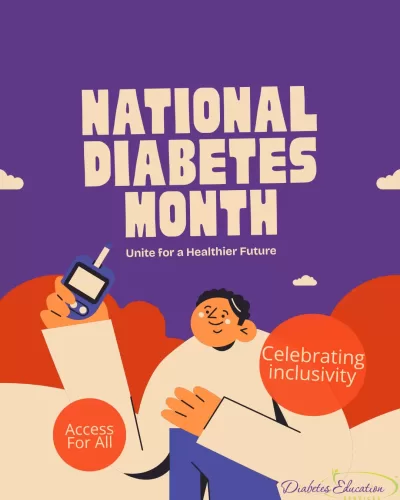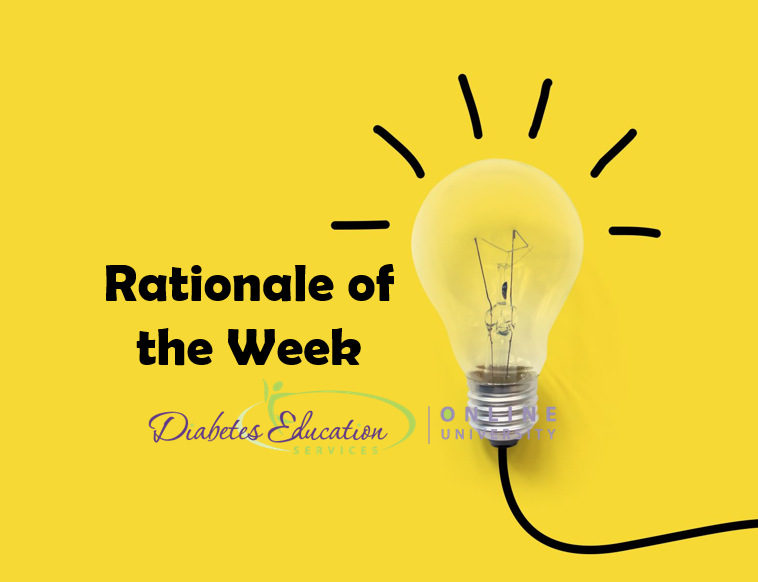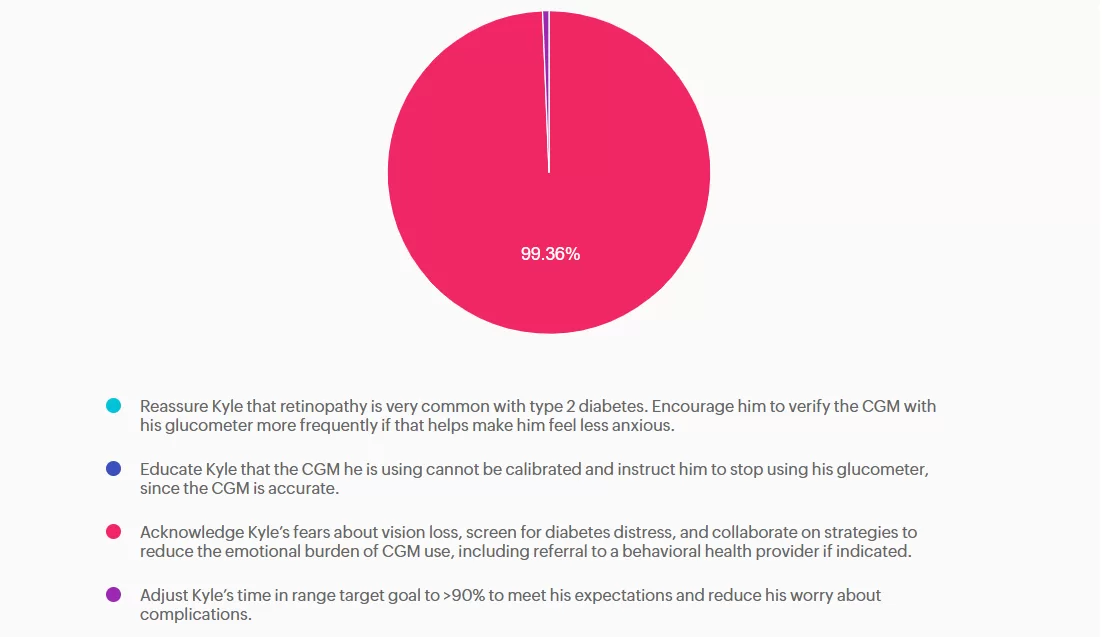
Ready to get certified?
Free CDCES Coach App

Subscribe
eNewsletter
Download
Free Med Pocket Cards
Happy National Diabetes Month!

November kicks off National Diabetes Month
According to the latest CDC Data, over 16% of Americans are living with diabetes and 38% have prediabetes. This means about half of our communities are living with hyperglycemia.
Advocacy and education play essential roles in diabetes care and prevention. By equipping individuals with knowledge about diabetes management, healthy lifestyle choices, and preventative measures, we empower them to take ownership of their health and inspire change within their communities.
Personal and community actions
Community-centered education can be incredibly powerful—when people feel informed and supported, they’re more likely to make meaningful changes and encourage others to do the same. This creates a ripple effect, fostering healthier communities and potentially reducing the prevalence of diabetes over time.
Here are some activity ideas:
Wear blue: Wear blue on World Diabetes Day (November 14th) and throughout the month. You can also display a blue circle symbol in your window.
Participate in events: Join a Global Diabetes Walk or create your own. Support local chapter events hosted by organizations like the American Diabetes Association or Breakthrough T1D.
Host an event: Organize a fundraising event like a farm fresh sale or car wash, or host an educational session like a “Lunch and Learn” with a local expert.
Spread the word: Share educational content, personal stories, and facts about diabetes on social media, You can also share information via email or newsletters.
Post the Diabetes Risk test: Post the American Diabetes Association Risk Test (see below) in your organization’s or community’s newsletter.
FREE Webinars to Celebrate National Diabetes Month
We have put together a list of FREE Webinars and diabetes resources in English and Spanish to share with people living with prediabetes and diabetes. Thank you for your advocacy and belief that we can make a difference.
- From the Gut to the Butt- Exploring the GI System
- Prep for CDCES
- Revitalizing Diabetes Program
- Prep for BC-ADM
Websites that offer FREE handouts & info on diabetes
ADA’s Diabetes Food Hub – English and Spanish! Web site filled with information on healthy eating and an abundance of delicious recipes.
ADA Resources in Spanish – this newly opened information hub is perfect for those who prefer to learn and read in Spanish.
ADA’s FREE Life with Diabetes Program: ADA’s program includes six digital, printable journeys to teach how to live well with diabetes; a monthly e-newsletter with tips, stories, and more resources; six free issues of the Diabetes Forecast® magazine; access to an online community and local events. (The program is available in both English and Spanish).
ADA’s Risk Quiz: 60-second online risk assessment for type 2 diabetes. ADA created a self-assessment and a version to fill out the assessment for others. There’s also a printable version in English & Spanish that can be distributed to help ascertain risk. This is a great first step in helping individuals consider coming in for an appointment
CDC Diabetes Prevention Program Curricula and Handouts This site offers excellent resources for those interested in offering Diabetes Prevention Education in English and Spanish.
National Diabetes Education Program is an online library of resources compiled by the NDEP to help provide accurate information and support for people living with prediabetes and diabetes.
Spanish Language Resources: language can be a barrier to adequate and quality care. ADCES has created a number of free downloads for people with diabetes and prediabetes, which have been translated into Spanish.
Type 1 Diabetes Resource Page – Includes is a list of helpful online resources for Type 1 Diabetes. It include sites for national organizations like the American Diabetes Association (ADA), sites for diabetes interest groups, and other participant organizations that provide helpful diabetes tips and opportunities to join online groups.
Tech Resources
Panther Diabetes Technology Deciphered. Get to the gist of what you need to know. Essential resources and guidance for health care professionals working with diabetes technology.
DiabetesWisePro for Clinicians A non-biased web site for health care professionals that has a quick tool to access insurance coverage information, how to order devices, what to include and where to go for support.
DiabetesWise A non-biased website that helps people with diabetes learn about different diabetes devices and determine the best match for their needs
Insulin Cost Savings Toolkit Resource Page – An ADCES complete listing of low cost insulin options and resources.
Technology Cost Savings Resource Page – An ADCES listing of websites and information to obtain pumps and sensors for a lower cost.
Diabetes Cheat Sheets
Cheat Sheets: We have assembled an abundance of helpful diabetes education cheat sheets for healthcare professionals and those living with diabetes. Feel free to print and share!

Join our special guest speaker, Nick Kundrat, and join the conversation!
Beyond Blood Glucose: Empowering Health Through a Holistic Lens
November 19th at 11:30 AM PST
Question of the Week | Gestational Diabetes: Diabetes Care in the Fourth Trimester

MT is a 29-year-old with Type 1 diabetes who is currently 14 weeks pregnant. She uses a continuous glucose monitor (CGM) with concurrent fingersticks and uploads her glucose data weekly. Her CGM settings was already set to the recommended time in range and the latest CGM report shows the following: time in range (TIR): 67%, time below range: 6%, time above range: 27%.
Based on current ADA Standard of Care, which of the following statements is most accurate regarding her CGM values?
- The recommended time in range is >70% within 70–180 mg/dL. MT’s TIR is slightly below target and her time below range is above the recommended targets, indicating adjustments are needed to reduce hypoglycemia.
- The recommended time in range is >70% within 63–140 mg/dL; MT’s TIR is slightly below target and her time below and above range is above the recommended goal.
- The recommended time in range is >80% within 63–140 mg/dL; MT’s TIR is below target, with fluctuations of hypo and hyperglycemia.
- The recommended time in range is >80% within 70–180 mg/dL to prevent fetal complications; MT’s TIR is significantly below the recommended Standard of Care target.
Join us November 19th at 11:30 AM PST

Level 5 | Beyond Blood Glucose: Empowering Health Through a Holistic Lens with:
Speaker Nick Kundrat, BS, CEP, CDCES, LMT
Get 30% Off Our Entire Collection of Online University Courses
Course credits through AMA PRA Category 1 Credits, ACPE, ANCC, and CDR!
Use the code Cyber30 for 30% off at checkout!
Rationale of the Week | Diabetes Tech and Diabetes Distress
For last week’s practice question, we quizzed participants on Diabetes Tech and Diabetes Distress. 99.36% of respondents chose the best answer. We want to clarify and share this important information, so you can pass it on to people living with diabetes and your colleagues, plus prepare for exam success!
Before we start though, if you don’t want any spoilers and haven’t tried the question yet, you can answer it below: Answer Question

Kyle is a 55-year-old man with type 2 diabetes for ten years. He was recently diagnosed with retinopathy in both eyes. His grandmother lost her eyesight due to diabetes. Due to this family history, he is very concerned about his new diagnosis. He uses a Libre continuous glucose monitor (CGM) to monitor his blood sugar levels. During your visit, he is preoccupied with checking his Libre CGM and tells you that he uses his glucometer to verify CGM readings at least four to six times per day. When you ask him about this, he reports that he can’t focus on his work or home life if he isn’t over 90% time in range.
As a diabetes care and education specialist, what is the best approach to this situation?
- Reassure Kyle that retinopathy is very common with type 2 diabetes. Encourage him to verify the CGM with his glucometer more frequently if that helps make him feel less anxious.
- Educate Kyle that the CGM he is using cannot be calibrated and instruct him to stop using his glucometer, since the CGM is accurate.
- Acknowledge Kyle’s fears about vision loss, screen for diabetes distress, and collaborate on strategies to reduce the emotional burden of CGM use, including referral to a behavioral health provider if indicated.
- Adjust Kyle’s time in range target goal to >90% to meet his expectations and reduce his worry about complications.

Getting to the Best Answer
Answer A is incorrect: 0% chose this answer, “Reassure Kyle that retinopathy is very common with type 2 diabetes. Encourage him to verify the CGM with his glucometer more frequently if that helps make him feel less anxious.” This is incorrect. Although diabetes retinopathy is a common complication of diabetes, it is not inevitable, and the risk can be reduced by maintaining optimal glycemic control. Additionally, verifying blood glucose levels with a glucometer when there appears to be no issue with his CGM will not alleviate his anxiety.
Answer B is incorrect: 0% chose this answer, “Educate Kyle that the CGM he is using cannot be calibrated and instruct him to stop using his glucometer, since the CGM is accurate.” This is incorrect. Though his particular CGM cannot be calibrated, fingerstick blood glucose readings are the gold standard when CGM readings are unexpectedly out of range.
Answer C is correct: 99.36% chose this answer, “Acknowledge Kyle’s fears about vision loss, screen for diabetes distress, and collaborate on strategies to reduce the emotional burden of CGM use, including referral to a behavioral health provider if indicated.” This is correct. Kyle is demonstrating symptoms of diabetes distress due to fear of ocular complications, perfectionism, and technology overwhelm. The ADA Standards of Care 2025 recommend routine screening for diabetes distress and other psychosocial concerns at least annually or when complications arise.
Answer D is incorrect: 0.64% chose this answer, “Adjust Kyle’s time in range target goal to >90% to meet his expectations and reduce his worry about complications.” This is incorrect: The time in range goal for most adults living with diabetes is >70%. Adjusting his time-in-range goal to >90% will not work to reduce his obsessive behavior.
We hope you appreciate this week’s rationale! Thank you so much for taking the time to answer our Question of the Week and participate in this fun learning activity!
Get 30% Off Your Entire Order!
From November 30th to December 2nd, use the code “Cyber30″ for 30% off at checkout!
Save the date and shop our sale
Simplifying Insulin Delivery with CeQur Simplicity

The American Diabetes Association estimates that over 8 million people in the United States depend on insulin therapy for survival.¹ Multiple daily injections (MDI) of insulin can be challenging to manage. Diabetes care and education specialists understand that complex medication regimens often lead to difficulty achieving medication adherence and worsening glycemic control.²
CeQur Simplicity is a unique alternative to MDI therapy. It redefines insulin delivery with a wearable device that administers insulin with just a few clicks. By simplifying insulin delivery, CeQur can support successful insulin management and improve glycemic control without the hassle of multiple daily injections.
What is CeQur Simplicity?
The CeQur Simplicity patch is a wearable insulin delivery device for adults aged 21 and older, approved for individuals with type 1 or type 2 diabetes who require insulin. This thin patch can hold up to 200 units of either U-100 lispro (Humalog) or U-100 aspart (Novolog) insulin. The patch can be used for up to 4 days on any approved insulin injection site. It is usually worn on the abdomen, thigh, or upper arms, as these areas are more accessible for reaching the CeQur device.³
Pressing the buttons on the sides of the device delivers two units of insulin. Each press produces an audible click to announce delivery. Over the 4-day wear period, this wearable insulin device replaces up to twelve meal bolus injections. The ease of use and ability to dose without carrying and storing insulin or injecting it can be freeing for many people living with diabetes. Research has found that when using the CeQur patch, users were more satisfied with the device, experienced less diabetes-related burden, and missed fewer insulin boluses.
CeQur is not an automated insulin delivery system. This device operates independently and does not connect to continuous glucose monitors. The CeQur Simplicity is not approved for basal insulin and does not replace the need for basal insulin.
Who is an Ideal Candidate for CeQur Simplicity?
Diabetes healthcare professionals can help identify clients who may benefit from the CeQur Simplicity insulin patch. An ideal CeQur candidate may be those who:
- Feel overwhelmed by technology
- Have anxiety related to injections or are experiencing injection fatigue
- Want a less complicated routine
- Are frustrated with always carrying insulin pens and supplies
- Want a discreet wearable device
- Are unhappy with their current MDI therapy
The Diabetes Healthcare Perspective
The healthcare professional’s (HCP) role starts with explaining the CeQur Simplicity device and how it differs from traditional insulin pumps and insulin pens. Besides identifying those who may benefit from CeQur, the HCP also provides training and troubleshooting for CeQur. CeQur training includes demonstrating how to apply and remove the device, using the click-based bolus feature, and performing site care and rotation procedures. This hands-on education helps clients build confidence in their new insulin delivery device. HCP’s can also assist in exploring cost, insurance coverage, and manufacturer support programs.
Here are other considerations for the diabetes healthcare professional:
✅ Assess the ability to count by 2s as the device only delivers doses in increments of 2 units.
✅ Fill the CeQur device with insulin just before use and never prefilled in advance.
✅ Do not apply a CeQur insulin patch near the area where basal insulin is injected.
✅ Avoid applying the insulin patch to areas that will be irritated by clothing, accessories, or a seat belt.
✅ Use the ‘Change By’ sticker provided with each device as a reminder of when the device needs to be changed.
✅ Avoid submerging the patch more than 3 feet 3 inches (1 meter). Also, do not squeeze the dosing buttons while the patch is underwater.³
Diabetes healthcare professionals work to identify and address barriers to insulin therapy. Collaborating with clients can boost their confidence, foster effective diabetes self-management, and improve their psychological outcomes. For those who are frustrated with their current MDI therapy but are also leery of AID systems, the CeQur Simplicity insulin patch may offer fewer injections, freedom from carting around meal-time insulin, and an improved quality of life.
References
- American Diabetes Association. (2022, June 22). American Diabetes Association announces support for INSULIN act at senate press conference. [Press Release]. https://diabetes.org/newsroom/american-diabetes-association-announces-support-for-insulin-act-at-senate-press-conference
- Ab Rahman, N., Lim, M. T., Thevendran, S., Ahmad Hamdi, N., & Sivasampu, S. (2022). Medication regimen complexity and medication burden among patients with Type 2 Diabetes Mellitus: A retrospective analysis. Frontiers in Pharmacology, 13, 808190. https://www.frontiersin.org/journals/pharmacology/articles/10.3389/fphar.2022.808190/full
- CeQur Simplicity. (n.d.). Resources & support. Retrieved September 1, 2025, from https://myceqursimplicity.com/resources-support/
Question of the Week | RT Forgot Their Insulin- Best Response?

RT has type two diabetes and has been maintaining a time and range of 70% or greater. However, when they show up at the office, the last week’s time in range dropped to 30%. You ask what was different this week from the previous few months. RT tells you they went on a five day fishing trip and forgot their insulin.
What’s the best response?
- Next time, make sure to take your insulin and put it in the refrigerator for safekeeping.
- Before we dive into the diabetes stuff, tell me about your fishing trip.
- I’m worried that you’re going get complications due to high blood glucose levels.
- I’m just relieved you did not go into diabetes ketoacidosis.

Level 5 | Beyond Blood Glucose: Empowering Health Through a Holistic Lens with:
Speaker Nick Kundrat, BS, CEP, CDCES, LMT
Rationale of the Week | FIB-4 of 2.83. What Action Required?
For last week’s practice question, we quizzed participants on FIB-4 of 2.83. 48.09% of respondents chose the best answer. We want to clarify and share this important information, so you can pass it on to people living with diabetes and your colleagues, plus prepare for exam success!
Before we start though, if you don’t want any spoilers and haven’t tried the question yet, you can answer it below: Answer Question

AR lives with type 2 diabetes, and their waistline is 41 inches. Since their ALT and AST levels are elevated, you know they are at risk for steatosis (MASH). You quickly calculate their Fibrosis-4 Index (FIB-4), by plugging in AR’s Age, AST, ALT, platelet count into the FIB-4 calculator. AR’s result is 2.83.
According to the ADA Standards, with a FIB-4 value of 2.83, which action is required?
- Start AR on pioglitazone and recheck FIB-4 in 3 months.
- Encourage AR to see a RDN and stop consumption of alcohol immediately.
- Suggest increased high intensity activity coupled with a GLP-1 to reduce body weight.
- Refer AR to liver specialist for further evaluation.

Getting to the Best Answer
Answer A is incorrect: 18.4% chose this answer, “Start AR on pioglitazone and recheck FIB-4 in 3 months.” Although pioglitazone is a recommended treatment for steatosis, since AR’s FIB- is greater than 2.67, this indicates AR is at high risk for advanced fibrosis and a referral to a liver specialist is warranted.
Answer B is incorrect: 15.11% chose this answer, “Encourage AR to see a RDN and stop consumption of alcohol immediately.” Seeing a RDN is very important for AR to evaluate and customize an eating plan to address their steatosis and support quality of life. However, since AR’s FIB- is greater than 2.67, this indicates AR is at high risk for advanced fibrosis and a referral to a liver specialist is warranted.
Answer C is incorrect: 18.4% chose this answer, “Suggest increased high intensity activity coupled with a GLP-1 to reduce body weight.” Strength training and activity, coupled with a GLP-1 for GLP-1/GIP are important strategies to address steatosis. However, since AR’s FIB- is greater than 2.67, this indicates AR is at high risk for advanced fibrosis and a referral to a liver specialist is warranted.
Answer D is correct: 48.09% chose this answer, “Refer AR to liver specialist for further evaluation.” Great job! AR will require intensive intervention to decrease their risk of worsening steatosis, including MNT, targeted activities, and a referral to a liver specialist to determine the best treatment approach.
We hope you appreciate this week’s rationale! Thank you so much for taking the time to answer our Question of the Week and participate in this fun learning activity!
Updates in Lifestyle Therapy for MASLD and MASH


Metabolic Dysfunction-Associated Steatotic Liver Disease (MASLD) and metabolic dysfunction-associated steatohepatitis (MASH) are now recognized as high-risk health conditions for people living with diabetes.
Two out of three individuals with type 2 diabetes are affected by liver steatosis.¹ In May 2025, the American Diabetes Association (ADA) published a consensus report, which emphasized recommendations for early diagnosis, long-term monitoring, and highlighted lifestyle interventions as critical in preventing progression to cirrhosis.¹
In the past year, two medications have been approved for the treatment of MASH; however, lifestyle change remains at the foundation of treatment. These changes focus on improving dietary quality, increasing physical activity, promoting weight loss, and reducing sedentary behaviors.
Nutrition Therapy Approaches
Nutrition therapy, ideally guided by a registered dietitian nutritionist and reinforced by the entire diabetes care team, needs to be individualized to each person’s social, cultural, and financial needs.¹ Ivancovsky Wajcman et al. ² published a fascinating review of different country’s MASLD management guidelines summarizing recommended lifestyle interventions, their findings indicated many similarities with only a few differences.
Most groups recommended evidence-based eating patterns with the following themes:
- High in fiber and focused on whole food consumption, while reducing saturated fat, added sugars, and ultra-processed foods.¹
- Reduction of commercially produced fructose consumption was recommended as high fructose intake has been associated with greater fibrosis severity, independent of total calorie intake.
- A few guidelines specifically called out reduction/avoidance of regular soda consumption emphasizing that consuming more than four servings of regular sodas per week was associated with a 45% higher risk of developing MASLD. ³
- In contrast, coffee consumption, whether caffeinated or not, has been shown in meta-analyses to reduce MASLD risk when intake exceeds three cups per day. Guidelines suggested consumption of greater than 2-3 cups per day. (Can I get a whoot for my daily coffee habit).
- Similar to the ADA Standards of Care for diabetes management, focusing on shifting towards water consumption and reducing the consumption of sugar-sweetened beverages has shown improved outcomes.
Other Recommended Eating Patterns & Physical Activity
The Mediterranean diet eating pattern is recommended in the MASLD/MASH ADA consensus report as well as the EASL–EASD–EASO Clinical Practice Guidelines ¹,²,³ due to its relationship with improving diet quality and evidence of hepatic and cardiovascular health benefits, even without weight loss.
Other dietary patterns, such as the low-fat, low-carbohydrate, Dietary Approaches to Stop Hypertension, high protein, meal replacement, and intermittent fasting, have also been shown to be comparable strategies to improve steatosis due to weight loss.¹
In people with overweight and obesity, the magnitude of weight loss has been associated with improving glycemic management, insulin sensitivity, as well as histological improvements in MASH.¹
Weight reduction over 5% has been associated with reduced steatosis, and greater weight loss of 7-10% has been shown to reverse steatohepatitis and liver fibrosis.¹,²,³ However, it is recognized that achieving long-term weight reduction may be challenging.³
Avoidance of alcohol is recommended for individuals with moderate fibrosis, as even modest use may aggravate injury.
Physical Activity, Stress Reduction & Sleep
Physical activity, including aerobic and resistance training, has independent effects beyond weight loss: decreasing intrahepatic fat, improving cardiovascular risk, improving insulin sensitivity, and supporting weight‐loss maintenance. Guidelines generally recommend greater than or equal to 150 minutes per week of moderate intensity (or equivalent) and resistance activities 2-3 times per week, with greater benefit when increasing activity.
However, reducing sedentary time and breaking up prolonged sitting bouts can be effective ways to reach this goal.¹,³ Emerging evidence highlights the importance of stress reduction, adequate sleep and treatment of sleep apnea, and management of comorbidities such as dyslipidemia and hypertension, due to their impact on liver steatosis, inflammation, and fibrosis.¹,²
FDA-Approved Medications
Until recently, there were no FDA-approved medications specifically for MASH; treatment was either off-label or targeted at comorbidities such as weight reduction or lipid and glycemic management. However, in the past 2 years, two different medications have been released to address MASH. In March 2024, the FDA approved resmetirom (brand name Rezdiffra) for adults with noncirrhotic MASH to be prescribed in conjunction with lifestyle therapy. 4 In August 2025, the FDA approved semaglutide (brand name Wegovy) for the treatment of MASH and moderate to advanced liver fibrosis. 5
MASLD and MASH
MASLD and MASH are high-risk health conditions for people with diabetes, with approximately 10-30% progressing to advanced liver disease, including cirrhosis.³ While new FDA-approved medications such as resmetirom and semaglutide offer promising options, lifestyle modification remains a cornerstone treatment.
As diabetes healthcare professionals, we are uniquely positioned to implement evidence-based strategies into the individualized care plan.
We can screen, educate, and empower individuals living with diabetes to take proactive steps that protect liver health, improve metabolic outcomes, and prevent progression to cirrhosis. Through nutrition and lifestyle therapy, pharmacotherapy, and incorporating broad strategies into DSMES services (¹) we can strengthen prevention and outcomes.
References
- Cusi K, Abdelmalek MF, Apovian CM, et al. Metabolic Dysfunction–Associated Steatotic Liver Disease (MASLD) in people with diabetes: the need for screening and early intervention. A consensus report of the American Diabetes Association. Diabetes Care.
2025;48(7):1057-1082. doi:10.2337/dci24-0094 - Ivancovsky Wajcman D, Byrne CJ, Dillon JF, et al. A narrative review of lifestyle management guidelines for metabolic dysfunction-associated steatotic liver disease. Hepatology. Published online August 15, 2024.doi:10.1097/HEP.0000000000001058
- Tacke F, et al. EASL–EASD–EASO clinical practice guidelines on the management of metabolic dysfunction–associated steatotic liver disease (MASLD). J Hepatol. 2024;81(3):492-542.doi:10.1016/j.jhep.2024.05.010
- US Food and Drug Administration. FDA approves first treatment for patients with liver scarring due to fatty liver disease. Published March 14, 2024. Accessed September 19, 2025. https://www.fda.gov/news-events/press-announcements/fda-approves-first-treatment-patients-liver-scarring-due-fatty-liver-disease
- US Food and Drug Administration. FDA approves treatment for serious liver disease known
as “MASH.” Published March 14, 2024. Accessed September 19, 2025. https://www.fda.gov/drugs/news-events-human-drugs/fda-approves-treatment-serious-liver-disease-known-mash
Get 30% Off Your Entire Order
From November 30th to December 2nd, use the code “Cyber30″ for 30% off at checkout!
Question of the Week | Diabetes Tech and Diabetes Distress

Kyle is a 55-year-old man with type 2 diabetes for ten years. He was recently diagnosed with retinopathy in both eyes. His grandmother lost her eyesight due to diabetes. Due to this family history, he is very concerned about his new diagnosis. He uses a Libre continuous glucose monitor (CGM) to monitor his blood sugar levels. During your visit, he is preoccupied with checking his Libre CGM and tells you that he uses his glucometer to verify CGM readings at least four to six times per day. When you ask him about this, he reports that he can’t focus on his work or home life if he isn’t over 90% time in range.
As a diabetes care and education specialist, what is the best approach to this situation?
- Reassure Kyle that retinopathy is very common with type 2 diabetes. Encourage him to verify the CGM with his glucometer more frequently if that helps make him feel less anxious.
- Educate Kyle that the CGM he is using cannot be calibrated and instruct him to stop using his glucometer, since the CGM is accurate.
- Acknowledge Kyle’s fears about vision loss, screen for diabetes distress, and collaborate on strategies to reduce the emotional burden of CGM use, including referral to a behavioral health provider if indicated.
- Adjust Kyle’s time in range target goal to >90% to meet his expectations and reduce his worry about complications.






